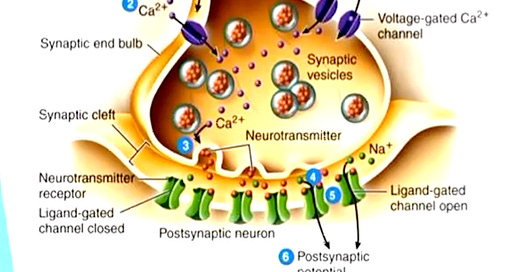synapses
communication between the neuron
the connection between the neuron
graded potentials
signals travelling down the dendrite and cell body
action potential or nerve impulse
signal that does down the axon, which leaves at the axon terminals and starts the whole process again
Synapse can be electrical or chemical
Electrical
gap junctions
faster
closer together —> ion channels close together
as mammals, not very common
Chemical
slower
lead to much more complex connection
common
How a chemical synapse works out
Nerve impulse arrives at the axon terminal
action potential has come down the neuron, and that will lead that neuron to synapse with the next neuron
this is an increase elec current
voltage gated calcium channels open, and calcium floods the cell
open ups when it is positively charged
Increase in calcium activates the synaptic vesicles (little bubble things)
these contain chemicals called neurotransmitters
activation of the vesicles leads to release of NT in the synaptic cleft
the little things merge with the cell (process called exocytosis) wall int o the synaptic cleft
the neurotransmitter in the synaptic cleft is free to bind to receptors on the postsynaptic neuron (little green trees)
specific neurotransmitters will bind to specific types of receptors
When the neurotransmitter binds to a receptor, in the example shown a ligand-gated ion channel opens.
this allows the movement of ions from outside the cell to inside the cell
this example allows sodium to enter the cell (this is positively charged) - this is called excitation, and more likely to fire
other neurotransmitters e.g chloride channels which are negatively charged inhibits the cell, less likely to fire
This excitation of inhibition of a cell is known as a post synaptic potential (or graded potential)
Neurotransmitters are generally returned to the presynaptic cell (recycling!)
Forms of synaptic communication:
we’ve talked about synapsing onto a dendrite
This is not the only type of communication that can happen!
a) axondendritic —> you synapse onto a dendrite (as the dendrite’s main purpose is to pick up information
b) axosomatic —> onto the soma
c) axoaxonic —> onto another axon
Graded potentials
neurons get information from other cells (at synapses), changing the electrical charge of the cell membrane
Decreases in voltage are inhibitory Post-Synaptic Potentials (IPSPs) of the cell membrane
Increases in voltage are Excitatory Post-Synpatic Potentials (EPSPs)
Graded potentials (EPSPs and IPSPs) can move across the cell membrane towards the axon hillock (vrooommmm)
information is summed so IPSPs and EPSPs can cancel each other out
inhibatory and exitatory information, and no action potential will fire
Action potentials
An action potential will only fire once the membrane potential threshold is reached at the axon hillock
all that information from multiple inputs is being summed together
It is a nerve impulse, a rapid electrical signal that travels down a single cell
it is about the movement of ions
Membrane resting potential is ~-70mV
Membrane threshold is ~-55mV
It all starts with the cell membrane:
the soma or cell body, the phosphholipid bilayer maintains the negative charge within the cell
forms a phospholipid Bilayer
The cell membrane is impermeable to movement
outside the cell there is a lot of sodium
inside the cell there is a lot of potassium
the cell membrane is negatively charged (-)
resting potential is -70mV
Concerntration gradient
cell membrane precents ions moving around
permeable membrande will diffuse evenly
Positive ions are drawn to neg charged spaces
Diffusion: based on the concerntration gradient
Elec Potential Diff: Whether it is POS or NEG
Important things to remmeber about ions
the cell is resting potential is negatively charged (-70mV)
the ions are prevented from moving around by the phospholid bilayer
sodium wants to get into the cell (55mV)
Potassium is pretty close to its equilibrium potential (-90mV), but wants to drive cell into more negative space
how the action potential looks
When you get a large enough post synaptic potential, and its HIT THE THRESHOLD for generating an action potential.
voltage gated sodium channels opening up
we know that sodium loves being in the cell, so sodium floods in
this leads to depolarization of the membrane which means the membrane gets more positively charged to around 40 mV
this is below where sodium wants to be, this is known as OVERSHOOTING, region above 0.
the reason it doesn hit 55mV where it wants to be is the channels only open very briefly, and also the Potassium is hating the change. It wants the cell to be negatively charged
Potassium pushes its way through the channels into the cell to make it negatively charged
this is repolarisation, rapid reduction in voltage of the cell
this is hyperpolarisation, or an UNDERSHOOT.
Refractory period when it levels out
think le chatelier’s principle
Message over 1m can be sent in 7ms. the process explained above of the graded potentials happens down the axon tail, until it hits the next neuron.
SEND ME A :CLOWN: IF YOU READ THIS












